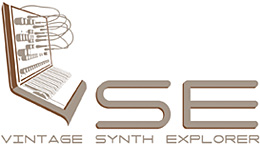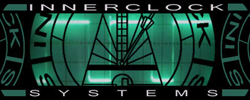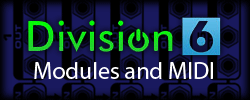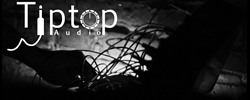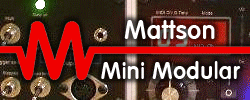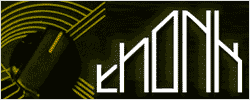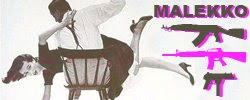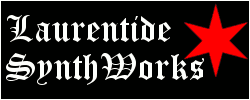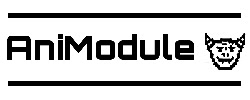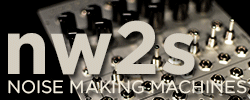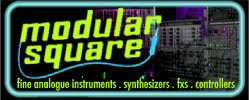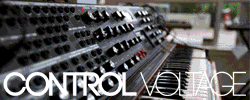The Self-Destructing Modules Behind Revolutionary 1956 Soundtrack of Forbidden Planet |

It’s four in the morning. You’ve just gotten home from a rough club date and you’re ready to relax a little before you drop off for the night. So you turn on the television and flip the dial, looking for something besides low-budget advertisements for carpeting and mail-order merchandise. Suddenly a flying saucer appears on the black-and-white screen, and the next shot reveals an otherworldly desert planet surface peopled by square-jawed, buzz-cut Marine types wearing leotards. The perfect thing: an old 1950s sci-fi flick. Then you notice the soundtrack: Weird, swooping electronic glissandi that rise to a climax, only to begin again. Burbling backgrounds, drenched in reverberation. Sonorities evocative of the pre-Star Wars conception of outer space.
Chances are, the sounds you’re hearing were inspired by the ground-breaking work of Louis and Bebe Barron. In 1955 the young husband-and-wife team was hired by MGM to produce the first completely electronic score for a commercial film, an innovative science-fiction classic called Forbidden Planet. (The original soundtrack is available from Small Planet Records, Box 3799, Beverly Hills, CA 90212.)
In an age when keyboard players— simultaneously performing the duties of performer, composer, and producer—are cranking out electronic film scores by the dozen, with results potentially indistin-guishable from those produced by more conventional means, it’s hard to imagine a time when the very idea of an electronic score was virgin territory. The movie’s titles, however, credit the Barrons with having created not electronic music, but “electronic tonalities”—partly to avoid a lawsuit by the American Federation of Musicians. And yet, 30 years later, we have Vangelis’ Chariots of Fire, Jerry Goldsmith’s Runaway, Michael Boddicker’s Magic Egg, Maurice Jarre’s Dreamscape, Tangerine Dream’s
Legend—not to mention Miami Vice on TV. That’s how thoroughly the revolution initiated by Louis and Bebe Barron has caught on.
As the Marx and Engels of electronic film scoring, the Barrons have
certainly been aided and abetted by subsequent technological
developments which, over the past 20 years, have put the tremendous
resources of subtractive, additive, and FM sound synthesis under
keyboard control, and have allowed computers to memorize
keyboard-generated input. Today, how¬ever, the Barrons’ unique approach
to electronic music suggests alternative ways of composing, of designing
sounds, and of thinking about the relationships between music and
technology.

Consider the state of electronic sound production in 1948, when the Barrons received one of the first tape recorders in the United States as a wedding gift from a German friend.
The shock value of early electronic instruments, such as the Theremin, had somehow worn off without generating much momentum for further exploration; academic musicians were still mired in esthetic arguments over the rela-tive merits of Schoenberg and Stravinsky. The first “classical” electronic music stu-dios, wedding the new tape-recording technology with the tone-generating capabilities of radio test equipment (using pre-transistor technology), were still under construction by Vladimir Ussachevsky and Otto Luening in New York, Pierre Schaeffer and Pierre Henry in Paris, and Karlheinz Stockhausen in Germany. The first keyboard-controlled synthesizer was just a gleam in Robert Moog’s eye. It was against this background that Louis Barron, a pianist, composer, and ham radio operator, along with his wife Bebe, also a pianist and composer, began to experiment with the sound-generating circuitry that eventually landed them the Forbidden Planet score.
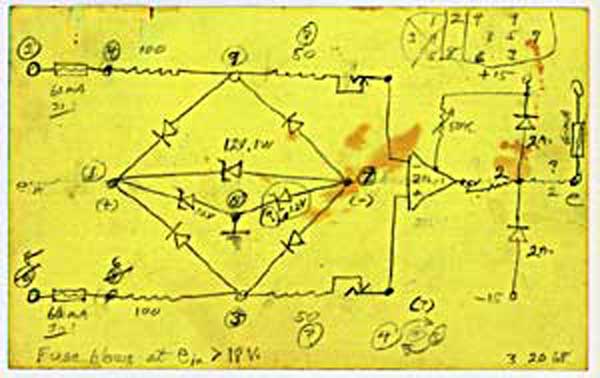
At that time the Barrons were living in New York’s Greenwich Village, taking part in the artistic ferment which developed there shortly after World War II. “There was something in the air,” Louis recalls, “drawing artists to Greenwich Village. It wasn’t a concerted movement, like the hippie thing. It just happened; we were all drawn there. We set up one of the only recording studios around, recording poets, writers, musicians—it was very interesting. We were earning money half of the time, and doing our thing the other half.”
They became associated with John Cage, who was working on a foundation- sponsored investigation of the nature of sonic perception. Under Cage’s direction, the pair created a library of sounds. “He had us make up sounds to fit into eight categories,” Louis recalls. “We had little sounds, like striking a match—not necessarily sounds of low volume, but sounds you would associate with something small—and country sounds, city sounds, electronic sounds, and so on. Cage had a grant for six months, and part of that covered part of our rent. You pick up a great deal of enthusiasm working with someone like John Cage. And you realize that you don’t have to be restricted by the traditions, or the so-called laws, of music. So we began exploring, and I began developing my circuits.”
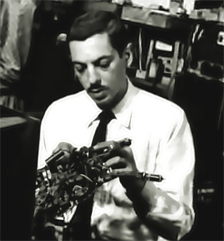
During those years they also collaborated with surrealist author Anais Nin on a film entitled The Bells Of Atlantis (1952), the first motion picture to have an all-electronic score. The sound-generating circuits constructed for that film seemed to suit the abstract nature of the film particularly well: “The score turned out to be very apropos of both where the film was, and where peoples’ heads were within the avant-garde,” Louis explains. “It established our foothold in the artistic community.”
“We were involved very much with the making of that film,” he continues. “We participated in the shooting, the editing, even the selection of the text.” A review in Vogue observed that its score, “without sharp definition, without musical prece¬dent, without association or logic except that of its own continuous flow, suits and underlines the visual image, the verbal evocation as if all three elements had been created by one instantaneous act.”
Their experience with The Bells Of Atlantis and a few other experimental productions whetted their appetite for scoring larger films. “We felt that there was a synergistic effect between the picture and the music,” says Louis. “Everybody thinks that film music is a bastard medium, but it presents a tremendous opportunity for collaboration. It would be ideal for the director, the cinematographer, the editor, and the composer to be in on the picture from the start so that they could exchange ideas.” Tantalized by the possibilities, Louis and Bebe plotted their assault on Hollywood.
The story of their transition from experimental film-making to scoring a feature for MGM contains all the elements of a Hollywood cliché, and Louis Barren tells it with a dramatic flair that suggests his recognition of that fact. The struggling young avant-garde artists had heard that MGM bigwig Dore Schary would be attending an opening at a chi-chi uptown gallery. “When we got there I told Bebe, ‘Look for the one who seems the least important. Schary’s the only one who doesn’t have to fake it’. Sure enough a man was standing there very neatly. Nobody was talking to him; everybody was having their cocktails with somebody else. I said, ‘That’s our man.’”
Schary agreed to listen to their tapes if the Barrons were ever out in California. Two weeks later Louis and Bebe went to Los Angeles. “We said, ‘When can we see you?’ He answered, ‘Are you free this afternoon?’ We found out later that Nicho-las Nayfack, who produced Forbidden Planet, had been trying to see him for two weeks, but he was always busy.” Schary refused to watch The Bells Of Atlantis, preferring simply to listen to the music. “He was very non-commital. He said, ‘Well, what are your commitments?’ I said, ‘Oh, we’re flexible.’ He said, ‘Do you have any commitments?’ I said ‘No.’”

Leslie Nielson at the helm of the United Planets Cruiser C-57D as it speeds, in response to a distress signal, toward Altair IV – Forrest J Ackerman, Science Fiction Cinema Archives, Hollywood.
The Barrons began working immediately. “They sent us to a screening room to see Forbidden Planet, in rough-cut form, with all the dialog and most of the routine sound effects of doors opening and footsteps. Bebe wasn’t very impressed; to her it was just another movie. To me, it had a certain joie de vivre, it had a happy purpose.” MGM offered to transport their studio from New York to Los Angeles, but the Barrons declined for the sake of practicality: “It would have been ridiculous to transfer all our equipment to Hollywood for a three-month job.” The studio agreed to let them work in New York. Forbidden Planet became the first MGM score ever to be produced outside of the studio lot—a precedent comparable to that set in the world of television by Jan Hammer’s current work for Miami Vice in New York.
“Schary told the head of the music department, Johnny Green, ‘I don’t want you to interfere with their work. I want the Barrons to do their best thing. Just tell them to go ahead and use their best judgment.’ The resulting soundtrack integrates underscoring, source-music (music that actually occurs on-screen in a given scene), and sound effects in a brilliant and, for the time, a completely new way. The Barron’s score makes no distinction between the emotional underscoring of the love scene, the sounds of the United Planets Cruiser C-57D whizzing toward the planet Altair, and the otherworldly strains of music created by the long-extinct Krell civilization. During a scene in which the audience is shown a vast extraterres¬trial power plant, it is impossible to know whether the soundtrack represents an ominous intent on the part of the film’s director, or the sound of the alien machin-ery itself.

“We took upon ourselves the privilege of ignoring conventions,” Louis asserts. “We did our own editing and recording, so we didn’t feel that we had to limit our-selves to what the musical score had been doing. We felt that we could invade the domain of sounds, and in that way build bridges, from time to time, between what’s happening on the screen and what you’re hearing.” They see this as an exten¬sion of standard soundtrack-mixing tech¬niques: “In a Western chase scene, you have the sound of the horses’ hooves blending with the background music, until it’s not clear which is music and which is the sound of the horses. I think that’s good.” Nonetheless, this complete obli¬teration of distinctions between music and effects, usually produced by two utterly separate processes, anticipates by a good 25 years the innovations wrought by Suzanne Ciani in advertising music, and by Alan Howarth in film.
At the same time, the Barrons did not disregard film-scoring traditions entirely. In classic Hollywood fashion, “we tried to establish leitmotifs for various characters,” each represented by a different system of sound-generating circuits. The music attributed to the Krell civilization—the only source-music in the movie—was originally to be handled in the usual way, by having it produced independently. “The producer wanted to bring in [microtonal composer/instrument builder] Harry Partch to do it, but the music department said no. So we did our Krell music, and it was the most popular part.”
But the Barrons’ music was not popular with everyone. Their work seems to balance tenuously on the pin-head of convergence between a number of divided disciplines: scoring and sound effects, academic and commercial music, technology and art, mainstream and avant-garde. At a time when crossing over occurred even less commonly than it does today, Louis and Bebe found themselves lacking support from any camp. “C.P. Snow, a novelist and mathematical physicist, called it ‘two cultures,’” says Louis. “The two cultures are, on the one hand the artistic, and on the other hand the scientific. And neither one understands the other, though that seems to be changing. I had the problem that either side thought I was for the other side. Actually, I was on both, caught in the crossfire.”
Bebe points out the split between the film music community and the academics. “We’ve always thought of ourselves as part of the same group as Cage, Ussachevsky, and the rest. But I was the only non-academic at the SEAMUS convention [Society for Electro-Acoustic Music in the United States, for which Bebe Barron serves as secretary].”

On the other hand, the Composers Guild wasn’t even sure whether the Barrons’ work should be considered music at all. “At one of their secret meetings, they discussed whether we should be admitted or not,” Louis recalls. “They decided we were a threat. And yet, this same guy who was important in the Guild would call me to ask how he could make a certain type of scene more interesting. The musical community absolutely hated the word electronic. Our greatest enthusiasm came from painters, poets, and dancers. Musicians felt that we were betraying the whole cause.”
This confusion caused some serious problems when their work eventually was nominated for an Academy Award. Honoring what the Academy had considered Forbidden Planet’s superb sound effects, the film was nominated in the special effects category. “So, when it came to announcing the nominations,” Louis recalls, “they gave credit for Forbidden Planet to the head of the sound department. And we didn’t work in the sound department; we worked in the music department.”
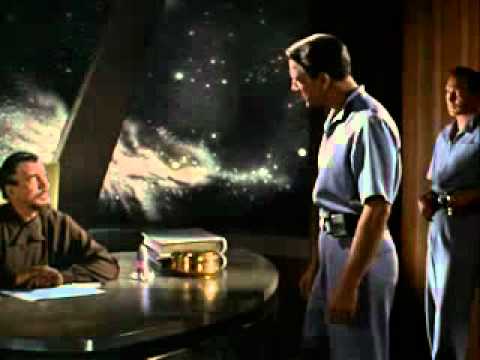
The resulting lawsuit, intended to attribute the credit properly, had the effect of further alienating the couple from the industry. In court the issue of credit became obscured in a fight for damages, and eventually the Barrons dropped the suit and went on to other projects, including a stage production of Gore Vidal’s Visit to a Small Planet. The damage, however, had already been done. “We couldn’t even get the movie score of Visit To A Small Planet, when our score had been so successful on Broadway,” says Louis.
The Barrons also suffered from another problem familiar to composers in Hollywood: typecasting. After Forbidden Planet, those in the industry had trouble imagining the Louis and Bebe’s music in any context besides a science fiction adventure. “We got heavily typecast as outer space music,” Louis confirms. “It’s that Hollywood thing—if you’re good at this, don’t do anything else.” While they see some validity to the connection between their music and outer space, they also recognize other possibilities. Before the couple moved west, Louis recalls, “people told us we were perfect for underwater music— films that take place under water. So it’s easy to associate the sounds with one thing, as though that were natural, and then find other directions that are just as natural.”
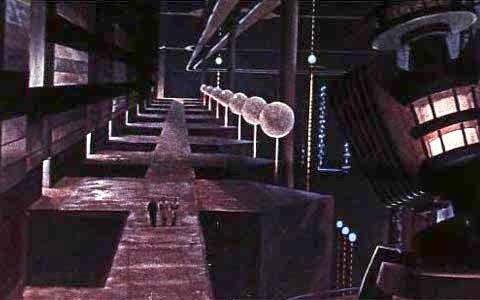
Furthermore, Louis Barron believes that the couple’s music doesn’t necessarily have to suit an entire movie in order to be useful. “I had thought that we’d be called in once in a while just to do certain scenes. That would have made a lot of sense. I’ve always thought that our music would go very well beneath emotional, melodramatic scenes. I still would like a chance to do a paranoid scene. The emotional expression that comes off these circuits would really fit a paranoid scene.”
Nonetheless, both composers express a great deal of enthusiasm for working with the medium of film. Bebe is particularly intrigued by the powerful effect that sound has on the image. “We scored a little film for Shirley Clarke called Bridges, for the World’s Fair in Brussels,” she explains. “As it turned out, we couldn’t give Shirley the rights to it because we had put a tiny bit of Forbidden Planet in it—we had only a week to do this, so we had to steal from ourselves—so she had to commission another score. She finally got a modern jazz score for it, and it’s really fascinating to see these two versions with totally different kinds of scores. It’s amazing. It turns it into a totally different film.” Today it is shown both ways.

The Barrons never scored another feature-length Hollywood production after Forbidden Planet. They have kept busy, however, with a number of diverse projects that run the gamut of music-and-visual combinations. There was a ballet produced by Standard Oil for a television special, a piece commissioned by General Dynamics Corp. to accompany a light show, and a Ford Fairlane advertisement for the J. Walter Thompson agency. In addition to Visit To A Small Planet, their work graced stage productions of The Happiest Girl In The World” (directed by Cyril Ritchard), John Houseman’s The Chinese Wall, and Legend by the American Mime Theater. They also scored several more experimental films, including Ian Hugo’s Jazz Of Lights and Miramagic by Walter Lewiston. Their music has also been presented at the Illinois Festival of Contemporary Arts, the first concert of the Baroness de Rothschild Foundation for the Arts and Sciences, and the Festival de la Recherche in Paris.
It is particularly appropriate—though not
without irony—that Forbidden Planet remains the couple’s best-known
work. If they weren’t so ambivalent about this, Louis Barron might call
it serendipity, one of several terms—among them cybernetics, information
theory, and entropy—that came up repeatedly during our meandering
conversation. The drive across Los Angeles’ tangle of freeways and into
the wilds of the San Gabriel mountains, where Louis keeps his studio, is
indeed akin to an interplanetary voyage from the familiar to the
extraterrestrial.
But there is a far more striking concordance. The film’s elusive
antagonists are not bug-eyed monsters but “monsters from the Id,”
creatures of the imagination which break away from the minds of their
progenitors, taking on independent identities, wills, lives of their
own. Which is precisely how Louis describes the circuits he designs:
each one possesses a distinct personality, which it expresses with its
own unique sonic character.
Louis Barron’s circuits are not like synthesizer patches. They aren’t made up of general-purpose modules, wired together in various configurations to produce different sounds. Each one is an entity unto itself. Louis sees his circuits not as mere machines, designed to produce some predictable sonic pattern on command. Rather, the essential aspect of their design is that they are unpredictable. Once activated, the circuit comes to life, wailing, screeching, or singing until some internal component becomes overloaded and fails. At this point the creature dies, emitting its final howls and whispers in a swan song of power failure.

The next step in the Barrons’ compositional process is to prod the circuit to life by “applying a stimulant. It could be a voltage coming in from the outside, or it could be letting more current pass internally by changing a resistance, or by adjusting some kind of feedback.” The method of control is always manual, a variable resistor or capacitor built right into the circuit. Louis doesn’t think in terms of filtering, amplifying, oscillating, or any of the component sound-shaping processes that synthesists are familiar with. “The circuit itself would have a number of those things going on internally to get the total result. If it sounded good to us, we’d try to capture it on tape. From then on we’d have the tape as working material.”
“Then I would go through all the tapes and find things I thought had potential for further processing, and were relevant to the film” Bebe says, explaining the methods used for Forbidden Planet. “Then together we would start processing, and that was the really fun part. The sounds didn’t come out of the circuits sounding the way they did in the end. We did lots of things to those sounds, although we were severely limited by the technology of the ’50s. But we did the usual kinds of things that people did in those days, like tape-speed changes and all. The processing would go on for weeks. One problem was that the tape and the equipment was so terribly poor in those days; we developed lots of noise. There were some things that were slowed down a hundred times, and by then you’ve developed a severe amount of noise.”
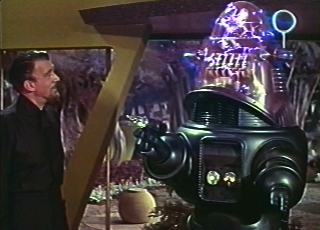
But, she points out, it’s not entirely accurate to break down their method into separate stages: “It’s really all one process. After a while, Louis and I got so that we didn’t even have to talk about what we were doing—like playing in a string quartet. We just knew exactly where we were going, and what we wanted to do.”
The compositions Louis and Bebe build from these sounds encompass timbres and formal structures similar, at least superficially, to much classical electronic music. Like the music of Mario Davidovsky or Morton Subotnick, it is characterized by a decided lack of anything approaching melody, harmony, or periodic rhythm. Instead, gestures of sound play with each other, chase and war with each other, floating and colliding in a timeless field of reverberation and tape delay. “To me,” Louis explains, “these circuits are as if a living thing were crying out, expressing itself. There’s an organic type of behavior going on.”
“The circuits’ life cycles have always been kind of a trademark of our stuff,” Bebe agrees. “It sounds like so much mumbo-jumbo, but it’s really true.” The Barrons’ ability to breathe virtual life into a concoction of tubes, capacitors, and resistors at one time attracted serious interest on the part of the scientific community. “It was really weird,” remembers Bebe. “A group of four or five scientists came up from the Salk Institute [in La Jolla, California] to visit us. They were studying the secret of life, or the origins of life, and they read something that Louis had written. They were so intrigued by this, they spent a whole day talking to us about the life cycles of our circuits,”
“This life-like quality makes our approach very different from what’s called the classical electronic music studio, which uses oscillators, filters, equalizers, and other laboratory instruments,” Louis points out. “Luening and Ussachevsky were getting started with that at the same time we were. I felt that that was the wrong direction, because laboratory instruments are made to be very precise and very definite, and people aren’t. Art isn’t. In working with the circuits, you think they’ll do one thing, and usually they do something even more interesting that you hadn’t expected. It’ll be an abstract thing, which can be linked to a different emotional experience, or a scene in a movie, or whatever. So I tried to make a circuit—not unpredictable, but with a built-in uncertainty.”
To Louis Barron’s ears, the absence of this uncertainty makes synthesizers as distasteful as the test equipment used by his fellow pioneers of electronic music. “A synthesizer is, designed to do something precisely and repetitively, even if the repetition is just the cycles of a sine wave. It’s locked in, it’s lobotomized—it doesn’t have a chance to express itself. It simply expresses what you want it to express, nothing more. But to turn that around, to ask what the circuit itself wants to express regardless of my intention, now that has an authenticity. It’s an authentic expression; it produces certain qualities that have feeling to them.

“Before the first synthesizers came out, we had been afraid of what would happen when people found a way to make crazy sounds, unpleasant sounds—it’s so easy to get unpleasant sounds. First of all, they would get the jobs and we wouldn’t. We depended on contract work. All of our contemporaries were subsidized by a university or, in Europe, by the radio stations, like Stockhausen and the French composers of musique concrete. Ussachevsky got hold of that huge quarter-million-dollar synthesizer that RCA built. It might be true that you’re more creative when you’re not commercially sponsored—I hate to think that—but somehow, I think, we were able to do things that were more interesting. I knew a whole new breed would come in, the ones who’ll do anything to make a buck, and that they’d make all of these noisy things, and that the producers would buy them because they don’t want to admit that the emperor has no clothes.
“But worst of all, I knew that the public would develop a horrible distaste for electronic music, that it would represent unpleasant, ridiculous sounds, that it would just pollute the esthetic environment. And it did, for a long time. It’s just now beginning to clear.
“Synthetic, to me, is the opposite of organic. Synthetic music lacks this life-like quality. I think that, to some extent, I’ve been able to create circuitry that doesn’t have a complete description of what it’s going to do. It makes sounds that you can resonate to, it creates an emotional rapport—emotional communication can be thought of as a kind of resonance, as when you strike a tuning fork and set another tuning fork vibrating: sympathetic vibrations.
“With synthesizers, you tell the machine what you want and then hope that it can do it. With me, I don’t know what I want—I’ve given up wanting. I might have an expectation, but I’m process-oriented. I care about what goes on, and I accept what comes out. If it sounds good, I accept it gratefully.”
“I just saw the new Yamaha stuff,” Bebe adds. “It’s very keyboard-oriented, isn’t it? It would be difficult to create an original sound with that stuff. It’s very inflexible, it seems to me.” She finds more timbral potential in sampling instruments: “Now, the Emulator, that’s quite remarkable. I have a feeling that that may be more interesting.”

The Barrons’ circuits present an intriguing alternative to keyboard control—indeed, to the entire concept of control itself. Louis’ ideas regarding control as a component of artistic expression share a great deal with those of John Cage. “The question is, should I be concerned primarily with what’s going to come out, or with what’s going on inside of me? This need to have control all down the line—the composer has to control the performer, the performer has to control the audience— this is an influence that we’re going to have to shed.”
But doesn’t he miss the kind of interaction a player can achieve through keyboard control? “I see more interaction in the way a Theremin works. It made some charming ballet numbers if the proximity of the dancers was controlling the music. That’s an example of a looser relationship, an opportunity for the performer to do something different—not just different for the sake of being different, but meaningful—different in a way that makes sense.
“There are times when using a keyboard would make life a lot easier,” he admits. “A pianist communicates with finger activities as well as notes. I used to play piano myself, but I haven’t heard the more recent keyboards that are acceleration-sensitive and pressure-sensitive. Synthesizers will definitely have a very important place, but I think the computer will be the primary control system.”
“I can’t believe how easily young musicians take to synthesizers,” Bebe reflects. “I was taking a course with the Buchla, and kids would come in and operate that thing like they grew up with it. I guess they did, didn’t they?” she adds. “The Buchla may be the only computer that would work for our kind of music. Our studio’s set up so that it’s really a two-man operation. One person simply cannot handle all that equipment. This was so neat and wonderful, all one little package.”
“But a computer is a very rigid thing,” Louis points out. “The greatest performing musicians almost always take liberties to stretch something, or to tighten it up. They’ll play with it; they’re not rigidly tied to a metronome. It’s actually the attitude with which you engage yourself, and the machine, that determines what comes out. There will be people who want to explore, but that exploration can’t be conducted with a computer at the moment. I’m interested in things that present computers can’t, or don’t bother, to do. They’re working on machines which will take their input in natural language, rather than artificial language. We should be able to throw a switch that allows occasional errors—not so much errors as discrepancies.
Surprisingly, however, in the Barrons’ studio today—a converted garage filled with old tape recorders, equalizers, oscilloscopes, rack-mounted tube amplifiers, and metal shelving covered with electronic components—sits a modified Oberheim Four-Voice expander module. Louis has wired jacks along the bottom of the front panel in order to gain access to various control voltages and audio signals. It’s connected to a plug-in routing matrix by a tangle of wires and alligator clips that looks like a spaghetti dinner prepared by R2-D2. “It’s convenient,” Louis explains. “I suppose, ultimately, the optimal setup would include the synthesizer, my circuits, and a computer. But I haven’t put that together just yet.”

The technology that made the Barrons’ creations possible, on the other hand, was the vacuum tube. Unlike the major developments of later years—transistors, integrated circuits, digital processing—tubes can absorb the stress of being fed more electricity than they are capable of processing. As Louis puts it, “Tubes are forgiving. The grid of a power tube may be expected to take one or two volts,’ let’s say,” he explains. “If you accidentally touch it with 300 volts, it’ll heat up, it’ll get red in the face. Take the voltage away and it’ll cool down, ready to do its normal thing. A transistor would blow in a fraction of a millisecond. And even if they don’t cost much, they’re a damn nuisance to keep changing.” In order to create electronic life, says Louis, “you have to be free to abuse the circuit.
“That’s part of it, but there’s something else,” he continues. “Transistors have odd powers, whereas tubes have even powers. That’s a significant factor. Even harmonics are rather pleasant, and odd harmonics are not.”
Louis’ formal background in electronic circuitry is not extensive; as Bebe puts it, “He was totally unhampered by any kind of formal education, so he could just let his imagination run wild.”
There is some method, however, to the calculated madness of the Barrons’ circuit designs. “You have to have some intuitive direction, rather than randomly poking around. If you sort of do it with feeling, very often something happens.” And that is the crux of the matter: regardless of the importance of technology in their work, feeling remains central to the Barrons’ music. “It only works if there is a sort of spiritual involvement with what’s going on,” states Louis. “It’s like these authors who say, ‘I wasn’t thinking when I wrote that. It’s coming through me.’ The same thing applies to musicians. Our psychology doesn’t even have a name for that, actually.”
The couple is well aware that their approach is somewhat out of step with the times. As Louis puts it: “There are times when I wonder if anybody will do this sort of thing again. For one thing, tubes are almost extinct. They were abundant when we began; 79 cents apiece. Now you can get some of them for $20.00 each, if you can afford to burn one out.”

Both of them feel, however, that the times themselves are not necessarily marching in the right direction. “The pace of life and work was very different in the ’50s,” Louis observes. “Now nobody has the patience to go through all that. I find it myself; I don’t have the patience that I had then. I used to spend weeks building something that didn’t live up to expectations, but I just kept going. But I feel it in the air. I see it all around me. It’s happening in so many fields. You don’t have the thoughtful mulling over of ideas any more. We have to get back to it. If we don’t, we’re not going to survive—because we don’t even know how to think about what’s going on today.”
“What’s missing now is a dialog among musicians and artists,” agrees Bebe. “Back in the ’50s we were all interested in each others’ work, in discussing our philosophies, matters of form and structure. It seems like today everyone’s just interested in the latest equipment.”
“There’s going to have to be a spiritual awakening,” Louis continues. “You can see it coming in the spiritual hunger that is resulting in so many new religions. People have to get their values disentangled. Right now they’re into money value. There’s something wrong with manipulating people for money; just like it’s wrong to manipulate people for sex, it’s wrong to manipulate them for money. That’s being promoted by selfish interests who are not only into money, but into control; they’ve got control as part of their thing. You’ve got to really work hard to get your head straight, because they can be very convincing. I don’t find people thinking about that now the way they did in the ’50s. I’m beginning to feel so nostalgic, it makes me want to cry.”

“What I find most disturbing,” says Bebe, “is that as the equipment gets more and more sophisticated, I don’t see the music keeping up with it.” As for electronic music in particular, Louis comments that “most of it is being made with glorified piano/organs.”
Echoing sentiments expressed by such Hollywood luminaries as Jerry Goldsmith—who is challenged to this day for his use of electronic instruments in his film scores—Louis asserts, “I still don’t feel that electronic music properly replaces anything. Certainly not an orchestra, nor any solo instrument such as a piano or a violin. These instruments can be played expressively by a human being, and cannot be played expressively by a computer. A computer, on the other hand, can play electronic instruments, and has the capability of doing a lot of interesting things that live musicians can’t do.”
As often as it is restated, both explicitly and implicitly, one crucial point seems to get lost in the musical shuffle. The Barrons proved it back in 1955 with Forbidden Planet, their music still attests to its validity, and keyboard players continue to demonstrate it every day. “Electronics,” Louis concludes, “extend the range.”
:format(jpeg):mode_rgb():quality(40)/discogs-images/R-10607940-1500850951-5335.jpeg.jpg)
Originally printed in Keyboard Magazine February 1986: 54-65. by Ted Greenwald
 BACK TO TOP
BACK TO TOP Synthesis (SYNTH) (from the ancient Greek "with" and "placing") refers to a combination of two or more entities that together form something new; alternately, it refers to the creating of something by artificial means. The corresponding verb, to synthesize (or synthesise), means to make or form a synthesis.
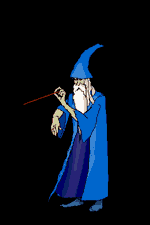
Wizard (WYZRD) n 1. a person who practises or professes to practise magic or sorcery 2. a person who is outstandingly clever in some specified field; expert 3. a wise man 4. computing a computer program that guides a user through a complex task adj 5. informal chiefly superb; outstanding 6. of or relating to a wizard or wizardry [ variant of wissard, from wise 1 + -ard ] 'wizardly adj wizard c.1440, "philosopher, sage," from M.E. wys "wise" (see wise (adj.)) ard. zynyste "magic," zynys "sorcerer," zyne "witch," all from zinoti "to know." The ground sense is perhaps "to know the future." "wise magical power!"

ControlVoltage
SynthWizards Network Directory
